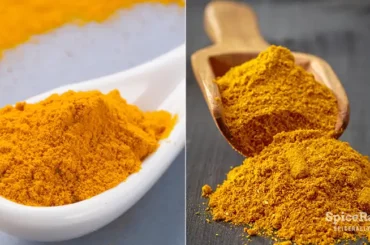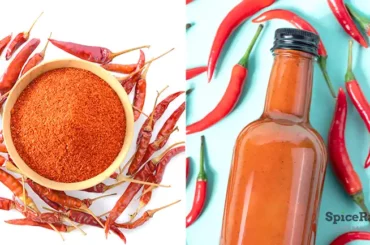This episode will be about two ingredients that are easily confused, and most of us fail to understand their differences. So, here’s all about biryani masala powder and biryani masala paste.
Indeed, the most apparent difference between biryani masala powder and biryani masala paste comes down to their textures. In addition, biryani masala paste tends to be more versatile in its application in various biryani recipes. They are different in ingredients, flavor, and color, whereas biryani masala paste is way more flavorful than biryani masala powder.
Read until the end to discover how these two ingredients differ, although they seem similar!

Biryani Masala Powder vs Biryani Masala Paste- SpiceRally Drill Down!
| Biryani Masala Powder | Biryani Masala Paste | |
|---|---|---|
| Base Ingredients | – Star anise – Caraway seeds – Green cardamom – Black cardamom – Cloves – Coriander seeds – Fennel seeds – Cumin seeds – Kashmiri red chiles – Bay leaves – Black peppercorns – Mace – Nutmeg – Cinnamon | – Star anise – Caraway seeds – Green cardamom – Black cardamom – Cloves – Coriander seeds – Fennel seeds – Cumin seeds – Bay leaves – Red chile powder – Black peppercorns – Mace – Nutmeg – Cinnamon – Fresh ginger – Fresh garlic – Oil – Fresh mint – Fresh coriander leaves (cilantro) – Salt |
| Base flavor | Warm and spicy | Spicy and savory |
| Other ingredients | Turmeric powder Garlic powder Onion powder Ginger powder Salt Dried plum Unripe mango powder Muskmelon Artificial colors, flavor enhancers, and preservatives Citric acid Anti-caking agents | Tomatoes Dried/ fresh/ fried onion Green chiles Saffron Sugar Acidity regulators Citric acid Tamarind paste Desiccated coconut Artificial colors Preservatives and other flavor enhancers |
| Texture | A dry, coarse powder. It may sometimes come as a fine powder. | A wet paste. |
| Flavor profile | Traditional biryani masala powder is warm, earthy, spicy, and very aromatic, with a bold taste of spices and herbs. If no additives are included, it can be less flavorful than biryani masala paste. | It can be more flavorful, robust,t and pungent than biryani masala powder. The fresh ingredients in this ingredient give it its bold, rich flavor and aroma. The flavor can vary slightly depending on the production. |
| Color and appearance | Light brown or orange in color. | Appearance can vary depending on how this is made. If a lot of fresh herbs are included, this paste has a greenish-brown color. Or else it can have a clay-like color. |
| Heat and spiciness | It can be less spicy than biryani masala paste, but the heat level depends on the quantity of chiles used. | It is spicier than biryani masala powder due to the addition of fresh spices and herbs., The heat level depends on the number of red chiles or amount of powdered red chile used. |
| Variations | Many variations exist depending on the region, household, and production. | Many variations exist depending on the region, household, and production. |
| Mode of usage in cooking | As an ingredient | As an ingredient |
| Usages in cooking | Mainly used in biryani making but also has other uses such as: – Spicing up curry sauces and gravies – Adding depth to fish, meat, or other seafood dishes – Flavoring up dal, grains, and eggs – Spicing up other rice dishes like pulao apart from biryani | Primarily used to make various types of biryani recipes |
| Availability | Widely available across India and can be bought under several brand names outside of India, from the international spice aisle of the supermarket, Asian stores, and online shopping sites. | Widely available across India and can be bought under several brand names outside of India, from the international spice aisle of the supermarket, Asian stores, and online shopping sites. |
| Storage | Can be stored in an air-tight glass container with the rest of your dry spices, herbs, and blends. Refrigeration is not required and it should be kept away from direct sunlight, humidity, and moisture. | Once opened, the leftover paste should be stored in the refrigerator. |
| Mode of production | Both commercially-made and domestic variations exist. | Both commercially-made and domestic variations exist. |
| Category of culinary ingredient | Spice blend | Spice blend |
| Origin | Indian cuisine | Indian cuisine |
Getting To Know More About The Difference Between Biryani Masala Powder And Biryani Masala Paste
Both biryani masala powder and biryani masala paste are common ingredients included when making various types of biryani. Both are specifically used in this dish but have a few differences, although the purpose is similar.
Biryani masala paste is made as a wet ingredient comprising both wet and dry elements. You’ll see many similar spices and herbs included in the biryani masala paste are shared in biryani masala powder as well.
But biryani masala powder is traditionally made with only dry, roasted herbs and spices. While biryani masala paste includes both dry-roasted and fresh herbs and spices, along with more additives. Therefore, biryani masala paste is considered a more versatile flavoring when it comes to making biryani.
Difference In Usage…
Biryani masala powder might give you more advantages than biryani masala paste would really do. As mentioned before, biryani masala paste is specified for making biryani.
But, biryani masala powder can be used as a general spice blend that can back up the taste of other types of rice, meat, fish, and seafood dishes or spice up some vegetarian dishes as well.
Consequently, even though biryani masala paste can be convenient, more versatile, and time-saving when it comes to biryani making, biryani masala powder can be helpful to you in many other ways in general cooking.
However, we don’t typically include both mixtures at once when making biryani. Thus, choosing between them entirely depends on one’s personal preference.
Can Biryani Masala Powder And Biryani Masala Paste Be Used Interchangeably?
Well, things get pretty tricky when it comes to this question. In essence, biryani masala powder and biryani masala paste can be used interchangeably only when it comes down to the preparation of biryani.
And it is essential to remember that you might experience a considerable flavor difference when these two ingredients are replaced for each other. However, when you are using biryani masala paste in your biryani recipe, adding extra ingredients like fresh ginger, garlic, or seasonings like salt is typically considered unnecessary.
Or else, they should be included mindfully since the paste already contains them all. But you will not get that if you use the biryani masala powder. So, if you are using biryani masala powder in place of the paste, you might have to include the extra ingredients.
At the same time, if you wish to use biryani masala powder in any other dish apart from biryani, then replacing it with biryani masala paste should always demand second thoughts!




